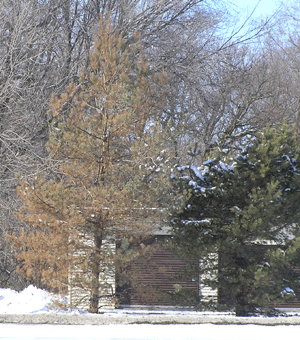The most common questions I have been asked lately are in regards to pine wilt. I thought I would take the time in this news article to clear all of these questions up. Pine wilt is a bad disease spreading rapidly throughout the area, so the more we know about it, the more trees we can possibly salvage.
Pine wilt is a disease that affects primarily Scotch pines, but it will also affect Austrian pines and less often ponderosa pines. The disease is one that is caused by a nematode, a microscopic worm-like creature, which burrows through the tissues in the wood and decreases the amount of water flow throughout the tree. The nematode is then moved from tree to tree with the help of a pine sawyer beetle. This beetle carries the nematodes on its back to new trees and when it bites into the next pine tree, it makes a wound in the tree where the nematode can go into it and start feeding, causing a large amount of damage.The needles on an infected tree will turn grayish green and will eventually turn all brown.
The death usually occurs over a short amount of time. The dead needles will remain on the tree well after the death occurs.
Management
There is no control method for pine wilt infected trees. If you have a tree that has or gets pine wilt it needs to be removed as soon as possible to prevent the spread of the disease. If your tree gets pine wilt after the first of October of the year, it should be cut down and burned or chipped by the end of April. If the tree dies between the beginning of May and the beginning of October it should be cut down and burned or chipped as soon as possible. This is done to reduce the spread of the disease and possibly save some of our beautiful Scotch pine trees.
Don't Mistake Pine Wilt for Other Common Diseases of Pine
There are two other diseases that affect these pine trees in similar methods that are commonly mistaken for pine wilt. Diplodia blight is one that mainly affects ponderosa and Austrian pines. The difference between diplodia blight and pine wilt is that in diplodia the pine cones will usually have tiny black spots on the cones which are the fruiting bodies of the fungus. This disease usually occurs as stunted and brown new growth or as entire branches that have brown needles.
The other disease of pine trees is dothistroma needle blight. Dothistroma affects mainly ponderosa and Austrian pines. The difference between dothistroma and pine wilt is that in dothistroma the needles will get dark brown bands across the needles that have turned brown. This disease is also different from pine wilt because it affects the bottom of the tree first and will eventually move up throughout the tree.
There are different fungicides that are available for use on both dothistroma and diplodia, but they must be applied two times each year. Pruning the diseased branches out of the tree can help to increase the air flow therefore reducing the incidence of the disease.
Photos by USDA Forest Service - Region 2 - Rocky Mountain Region Archive, USDA Forest Service, Bugwood.org


